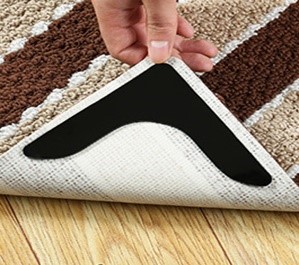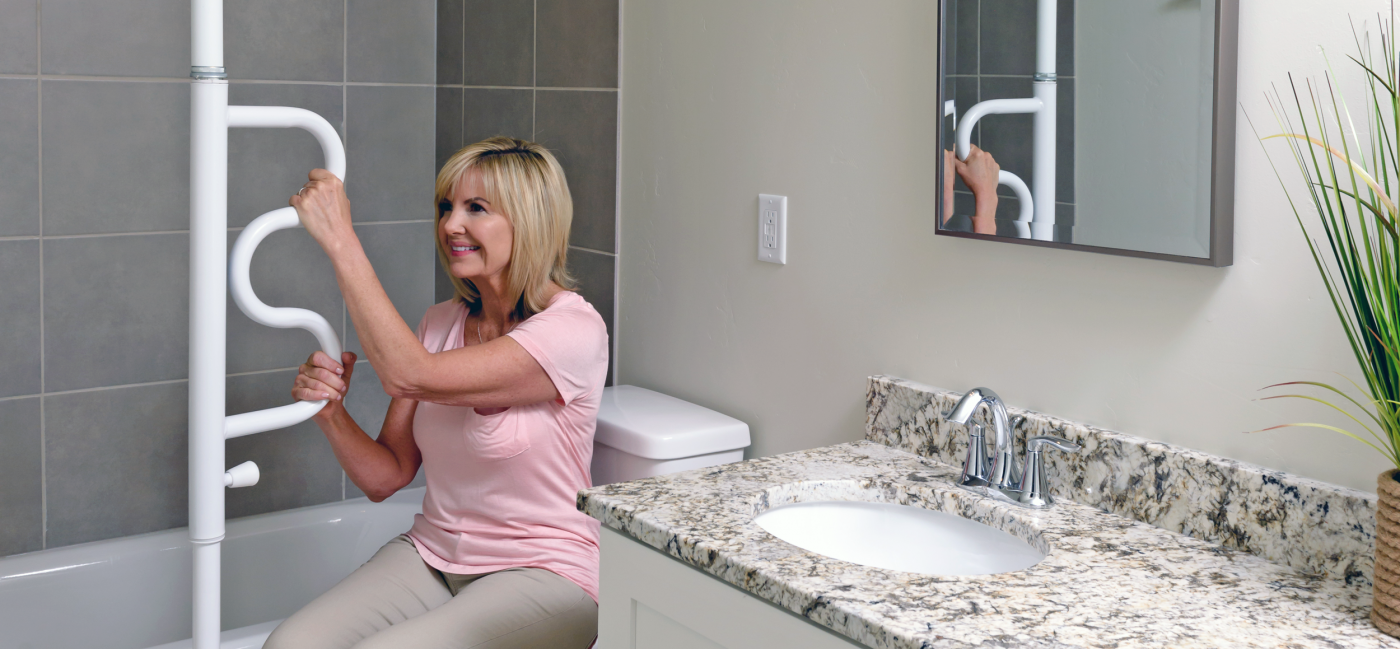“I NEED HELP. MY MOM KEEPS FALLING IN THE BATHROOM AND I DON’T KNOW WHAT TO DO.”
By authority on Fall Prevention and Caregiver Education
Emilia Bourland, OTR, ECHM

This is how the vast majority of conversations with my clients begin. A family caregiver, totally exhausted, exasperated, and frightened calls for help when they feel they have nowhere else to turn. It’s an all too common problem, and often, a serious injury has already happened, or is imminent. But that doesn’t mean there is no hope. On the contrary, there are simple solutions to many of the most common safety issues people face in the bathroom. So get a cup of coffee or tea, settle in, and relax while I share some of the most common fall risks in the bathroom, along with safety solutions to put your mind (and your back!) at ease.
Fall risk #1: Loose rugs and bathmats
Yes, rugs in the bathroom can play an important role. They soak up water, add decoration, and help keep bare feet warm (this is by far the most popular reason most people cite for wanting to hang on to rugs). But they are also common tripping hazards. Even rugs that lay completely flat can catch the toe of someone with trouble walking, and they can easily become bunched, tangled, or a barrier to wheelchairs and walkers. These problems can result in real frustration and serious injury for caregivers and the folks they are assisting. As an occupational therapist, when I’m working with someone on bathing, I make sure they, their feet, and the floor are dry before exiting the shower, and I use well secured slippers with rubber soles, or socks with grips to make sure there is no slipping or loss of heat into the floor. However, this process can feel unusual or cumbersome for home caregivers, particularly if the shower set up makes it hard to reach the person inside. For folks who absolutely must have or want rugs or mats in the bathroom, low pile options with rubber backing can be a safer option – but only in places where it is absolutely necessary to prevent the floor becoming slippery with water.
Fall risk #2: Slippery bathing surfaces
There are several reasons people are more likely to fall in the shower or tub  than other areas. When you are bathing, your body actually spends a lot of energy just maintaining it’s own temperature against the hot water. This leads to fatigue quickly for folks with limited energy resources. People with balance problems struggle even more when water or soap forces them to close their eyes. And, of course, if you add a hard surface that is wet and soapy, you’ve got a perfect storm of fall risk. To reduce this, many caregivers and individuals will place rubber mats, or even towels on the floor of their tub or shower. But, towels can float and become entangled around feet, and rubber mats can lose suction or become slippery themselves. Instead, I usually recommend using non-slip strips or stickers. These are available for only a few dollars, and generally work extremely well. The trick is to clean the bathing surface well, and then let it get completely dry before application…. Then, voila! A secure, non-slip surface. (Of note, there are also chemical treatments that can be applied to reduce slipperiness of a shower floor, but these should be professionally recommended and applied to ensure safety and prevent damage).
than other areas. When you are bathing, your body actually spends a lot of energy just maintaining it’s own temperature against the hot water. This leads to fatigue quickly for folks with limited energy resources. People with balance problems struggle even more when water or soap forces them to close their eyes. And, of course, if you add a hard surface that is wet and soapy, you’ve got a perfect storm of fall risk. To reduce this, many caregivers and individuals will place rubber mats, or even towels on the floor of their tub or shower. But, towels can float and become entangled around feet, and rubber mats can lose suction or become slippery themselves. Instead, I usually recommend using non-slip strips or stickers. These are available for only a few dollars, and generally work extremely well. The trick is to clean the bathing surface well, and then let it get completely dry before application…. Then, voila! A secure, non-slip surface. (Of note, there are also chemical treatments that can be applied to reduce slipperiness of a shower floor, but these should be professionally recommended and applied to ensure safety and prevent damage).
Fall risk #3: Safe entry and exit from the shower or tub
Possibly the biggest (and scariest) issue related to bathroom safety is entry and exit from the bathing area. If you’re a family caregiver, it’s likely you dread having to help with this transfer. This is also an area where very few “one size fits all” solutions are available. In this section, I’ll review different potential solutions and important things to know. However, to get the best, most cost effective, safest, and easiest solution that will work for you, my advice is to work first with an occupational therapist. Look for one with experience and additional education in home modifications. For example, the ECHM after my name means I have an executive certification in home modifications. This will ensure that you are working with someone who can see “The Big Picture,” along with the potential futures that exist based on you, your lifestyle, and your home. Plus, if you are planning for a remodel or other construction, occupational therapists with this skill set are likely to have relationships with contractors who are qualified to perform the work you require. With that said, let’s move on to some possible solutions and items to consider when thinking about safe bathing access.
-
- Curbless showers: The gold standard of safety and accessibility is the curbless, or “roll-in” shower. These are truly appropriate for EVERYONE, not just those with mobility problems. I encourage them to be part of any new construction project, whether or not there is a person with mobility limitations in the home, and they are certainly a recommendation for anyone wishing to age in place. Why are they so great?
- From a 30,000 foot view, curbless showers promote a high level of “visit-ability” and universal access, which means people of all abilities can have their needs met without difficulty or embarrassment.
- Besides making showers accessible for people of all abilities (family caregivers and loved ones alike), curbless showers also prevent trips and falls while stepping over a barrier. This means that having one can actually prevent injuries that may lead to short or long-term disability. In that way, they can help people keep their health and mobility much longer. I’ve often heard the argument, “Well, I only have to step over a few inches. It’s not going to be a problem.” And it’s true – when we are walking without trouble, a few inches is no big deal. But if you’re a caregiver for someone having mobility trouble, even 1 inch of barrier can stop an easy, safe entrance.
- Additional need to know: The big issue with these showers is drainage. I recommend contractors overcompensate for the anticipated flow to keep it from being a problem.
- Curbless showers: The gold standard of safety and accessibility is the curbless, or “roll-in” shower. These are truly appropriate for EVERYONE, not just those with mobility problems. I encourage them to be part of any new construction project, whether or not there is a person with mobility limitations in the home, and they are certainly a recommendation for anyone wishing to age in place. Why are they so great?
Of course, a bathroom remodel is often not realistic or possible. Fortunately, there are pieces of equipment and work arounds for almost any situation. Grab bars (see below) are nearly always useful for safe exits and entrances, and special types of seating systems can make difficult transfers safe and easy. Again, to determine which type of seating system, transfer equipment, or technique is appropriate for your specific situation, you’ll need to work with an experienced occupational therapist. He or she will be able to tell you the best strategy to use, recommend the correct equipment for your needs, and train you on the correct transfer technique.
-
- Grab bars: If you’re a caregiver thinking about environmental safety in the bathroom, one of the most obvious items that come to mind are grab bars. Grab bars are pieces of equipment that are specifically designed to hold a persons’ weight, when mounted to studs. Towel racks, soap dishes, toilet paper holders, shower handles, shower doors, and curtain rods DO NOT suffice as grab bars. Why? Most of these items are mounted into drywall only, and NONE of them were meant to hold the weight of a person. Using any of these for support will not only fail to stop a fall, but they can cause a fall if they come out of the wall while someone is holding on to them.
IMPORTANT: 2 things you NEED TO KNOW about grab bars BEFORE installation
- Just having grab bars mounted to a stud is not a fix all solution. Grab bars need to be both mounted correctly, AND mounted in the CORRECT location for them to be effective. No two bathrooms and no two people are exactly alike, which means that what works for one person is likely to be different from what will work for another. Working with an occupational therapist is (again) the best way to ensure you get what you need. A word of warning: I’ve seen far too many situations where well-meaning handymen mounted grab bars where they were totally useless, or even increased the risk of injury. It’s heartbreaking to have to tell someone that they just had holes drilled in their tile… in the wrong place. Save your neck and your wallet by working with an occupational therapist first.
- A suction cup is NOT the same as a stud. My clients frequently ask me how I feel about suction cup grab bars. The answer? NOT GOOD. I have never recommended one. Why? They have the ability to fail when they are needed (and do fail- I have seen the unfortunate consequences), and are often suctioned onto glass dividers or doors (which, remember, were never meant to hold a person). If you have a tricky bathroom that makes it hard to mount grab bars, call an occupational therapist. They have the knowledge to look at the whole situation and implement functional, effective solutions.
For example: The Security Pole and Curve Grab: When grab bars can’t go where someone needs bombproof support, there is always the option of a support pole. The Security Pole and Curve Grab from Stander is a support pole that runs from floor to ceiling. In the middle, two curved bars offer excellent handholds that offer grip from different angles. This pole and grab bar combined can be placed anywhere a person needs it, which can be handy near bathroom fixtures such as pedestal sinks or outside of tubs or showers where grab bars cannot be readily mounted for safe entry and exit. The Security Pole and Curve Grab comes with pre-drilled holes for bombproof mounting (always my recommendation for safest use), but is also rated to 300 lbs of force when used under tension between floor and ceiling. If using the bar under tension vs. mounted, the manufacturer recommends ensuring the tension is tightened periodically to ensure safety. Of course, to ensure the placement of the Security Pole and Curve Grab Bar is effective – without obstructing safe movement or the use of other mobility equipment – I recommend you work with an experienced occupational therapist.
If you need an occupational therapist in the Dallas area, feel free to reach out for a no-cost consultation. You can learn more about my Dallas based, fall prevention practice at https://www.aipctherapy.com/fall-prevention. You can also contact me directly by sending an e-mail to [email protected], or giving me a call at 469-998-1245.
If you’re a caregiver outside of Dallas who needs access to practical, high quality transfer training, check out my online family caregiver training program. It’s how I’m helping caregivers all over access high quality, practical, on-demand training to care for their loved ones safely… with LESS lifting. There are even options for LIVE Q&A and community membership, so you can connect with other family caregivers, and get the support you NEED. Check out https://www.higherstandardscaregivertraining.com/pages/family-training. You can also send me an e-mail at [email protected], or call me at 469-998-1245.
Health Advice Disclaimer:
Neither the Author, nor AIPC Consulting, LLC is providing medical advice or treatment of any kind in this article. No guarantees of specific results are promised or implied. People should seek medical advice from a licensed health care provider, such as a therapist at AIPC Consulting, LLC, if they feel they have a medical condition, impairment, disability, safety risk, or other needs related to health, wellness, and prevention. Author/AIPC Consulting, LLC is not liable for any injury or harm resulting from persons implementing tips, strategies, or information shared in above article or any other document, post, video, or otherwise produced content.

